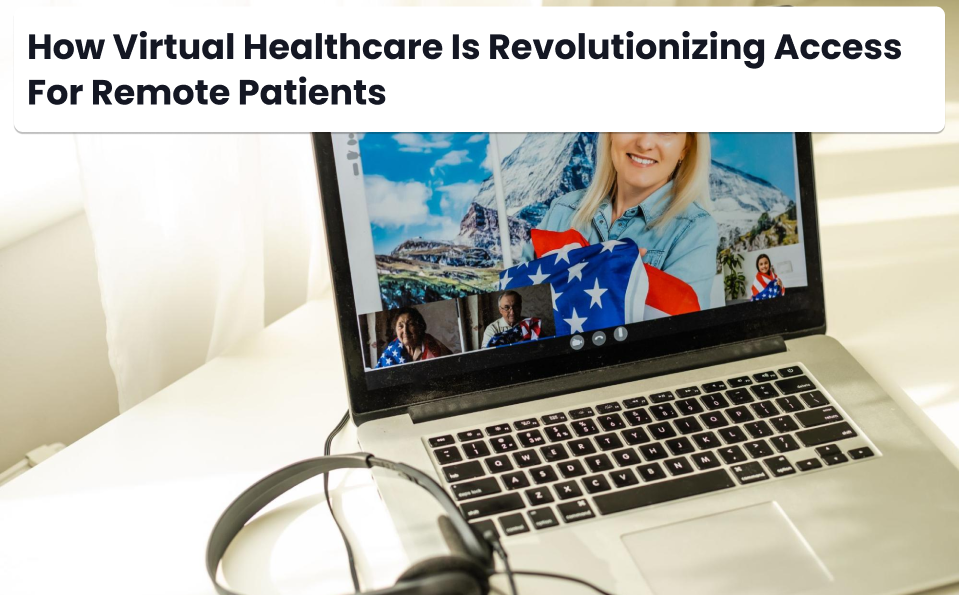
How Virtual Healthcare is Revolutionizing Access for Remote Patients
Imagine living in a small, remote town, tucked away from the hustle and bustle of city life. The nearest doctor is miles away, and the journey to get there is long, expensive, and filled with obstacles. For many people in rural areas of Canada and the United States, this is the reality they face every day. But then something remarkable happens—virtual healthcare comes into play, transforming the way these communities access medical care and providing a lifeline where there once seemed to be none.
Overcoming Geographical Obstacles
Let’s take a step into the shoes of Emma, a mother of two living in a quiet village in rural Canada. Emma’s health has always been a priority, but when she needs to see a doctor, the journey is a burden. The nearest clinic is a two-hour drive away, and with unpredictable weather in the winter, it’s often hard to even make it there. Virtual healthcare changes all that. Now, with just a few clicks, Emma can connect with a doctor right from her living room, without the worry of snowstorms or long drives. The power of telemedicine has broken down the barriers of distance, bringing medical care directly to her, wherever she is.
Accessing Expertise and Specialists
For people like John, who lives in the heart of Montana, the challenges of finding specialized care are even more significant. John has been dealing with heart issues for years, and every time he needed to see a cardiologist, it meant taking a trip across the state—an expensive and exhausting journey. But now, thanks to virtual healthcare, John can have a consultation with a top cardiologist without ever leaving his home. Through a simple video call, he’s able to access expert advice and get the care he needs—no travel required. For rural residents like John, telemedicine brings specialists to their doorstep, making it easier to access the right care at the right time.
Fast Attention and Prompt Interventions
Imagine Sarah, living in a remote part of Saskatchewan, Canada. Sarah’s son, Tim, is prone to asthma attacks, and in the past, when he had an episode, she would need to wait for hours to see a doctor. But with virtual healthcare, that wait is gone. Tim’s doctor can assess his symptoms in real-time and provide immediate guidance over the phone or through a video call. What used to be a stressful, lengthy process now becomes a fast, efficient experience. Virtual healthcare allows for quick interventions, especially in rural areas where timely care can be a matter of health and safety.
Patient Cost Savings
Then there’s Tom, a retiree from a small town in the U.S. who has long struggled with the costs of healthcare. Every visit to the doctor meant hours of travel, hotel stays, and expensive gas. For someone on a fixed income, these costs can add up quickly. But now, Tom can have his routine checkups from the comfort of his home. No more spending money on travel or accommodations—virtual healthcare brings the doctor to him. By eliminating unnecessary travel, telemedicine offers significant cost savings, freeing up resources for other important needs.

Patient Convenience
For many rural families, juggling jobs, school runs, and household chores leaves little time for doctor’s appointments. Meet Rachel, a busy mom who lives in a small town in Northern California. With two kids and a full-time job, finding time for a doctor’s visit was always a challenge. But with virtual healthcare, Rachel can schedule her appointments in the evening after the kids are in bed or during her lunch break at work. This flexibility has made it easier for her to take control of her health without missing a beat in her busy day.
Addressing Healthcare Shortages
In rural communities, healthcare providers are often few and far between. Many areas have just one doctor for hundreds or even thousands of patients. Take the case of Bill, who lives in a tiny village in the middle of nowhere. Bill’s doctor, who has been seeing him for years, is nearing retirement, and there’s no replacement in sight. For people like Bill, virtual healthcare is a game-changer. Through telemedicine, he can consult with a wide range of doctors and specialists from across the country. Healthcare professionals can collaborate remotely to ensure that Bill receives the best possible care, even when there aren’t enough doctors in his area to meet demand.
Remote Monitoring and Emergency Assistance
Sarah’s story doesn’t end there. Her son, Tim, not only benefits from virtual consultations when he’s feeling sick but also from continuous monitoring of his asthma. With a smart device that tracks his vitals and sends data directly to his doctor, Sarah can rest easy knowing that Tim’s condition is being monitored around the clock. If his symptoms worsen, the doctor is alerted in real-time and can step in before things escalate, reducing the need for costly and stressful emergency room visits.
The Hidden Benefits: Improving Mental Health and Reducing Isolation
Beyond physical health, virtual healthcare also has a profound impact on mental well-being, especially in rural communities. For those living far from family or friends, isolation can be a serious challenge. Sarah, in Saskatchewan, not only uses virtual healthcare for her son’s asthma but also accesses therapy sessions to help manage her own stress. Living in a small town can sometimes feel lonely, but through telemedicine, Sarah connects with a therapist who helps her navigate the emotional challenges of rural life. Virtual healthcare is no longer just about medical treatment—it’s about providing emotional support, helping individuals deal with the unique stresses of rural living.
Bridging the Digital Divide: Challenges and Solutions
While virtual healthcare has revolutionized rural healthcare, it doesn’t come without its challenges. In some areas, access to reliable internet is still a significant hurdle. For people in remote communities, slow or no internet can make telemedicine seem impossible. However, there’s hope. Many communities are investing in better internet infrastructure, and some health services are offering low-cost or loaned devices to make virtual healthcare accessible. Additionally, healthcare providers are learning to adapt by offering more phone-based consultations for patients with limited internet access, ensuring that everyone has a chance to benefit.
FAQ: Virtual Healthcare for Rural and Remote Patients
Q: What is virtual healthcare?
A: Virtual healthcare, or telemedicine, allows patients to consult with doctors remotely using technology like video calls and online messaging.
Q: How does virtual healthcare help rural areas?
A: It removes geographic barriers, providing access to healthcare without the need for long-distance travel, saving time and money.
Q: Is virtual healthcare covered by insurance?
A: Yes, many insurance plans cover virtual healthcare, but it’s best to check with your provider for specifics.
Did You Know? Fun Facts About Virtual Healthcare
Telemedicine started with space missions!
Astronauts used telemedicine in the 1960s to consult doctors during space missions.
See a specialist without traveling!
Virtual healthcare lets you consult top specialists from anywhere, even if they’re in another country.
Save money on healthcare!
Virtual healthcare can save you up to 50% on travel costs and related expenses.
Mental health care is more accessible!
Virtual services offer therapy and counseling, helping those in remote areas access mental health support.
In summary
Virtual healthcare has breathed new life into healthcare access in rural and remote parts of the United States and Canada. From breaking down geographic barriers to offering timely care, providing access to specialists, saving money, and even improving mental health, telemedicine has turned the impossible into the possible. For people like Emma, John, Sarah, Bill, and so many others, virtual healthcare has provided a way to get the care they need, without the stress and hardships that once seemed insurmountable.
As technology continues to advance, the future of healthcare in rural and remote areas looks brighter than ever. If you or a loved one lives in a rural area, virtual healthcare might just be the answer you’ve been searching for, offering access to the care you need—no matter where you are.





